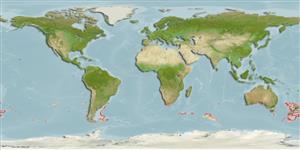Common names from other countries
>
Gadiformes (Cods) >
Macrouridae (Grenadiers or rattails)
Etymology: Coryphaenoides: Greek, koryphaina = dolphin fish + Suffix oides = similar to (Ref. 45335).
Environment: milieu / climate zone / depth range / distribution range
Ecologia
marinhas batidemersal; não migratória; intervalo de profundidade 900 - 1180 m (Ref. 1371), usually 900 - 1050 m (Ref. 1371). Deep-water; 33°S - 58°S, 14°E - 50°W (Ref. 1371)
Indo-Pacific: South Africa, south of Tasmania, New Zealand (including off Campbell and Chatham islands). Southwest Atlantic: off Falkland Islands and Argentina. Southeast Atlantic: off the southeast coast of South America (Ref. 33673).
Tamanho / Peso / Idade
Maturity: Lm ? range ? - ? cm
Max length : 37.0 cm TL macho/indeterminado; (Ref. 1371)
Espinhos dorsais (total) : 2; Raios dorsais moles (total) : 134; Espinhos anais: 0; Raios anais moles: 140. Barbel rudimentary. The second pectoral ray and the outer pelvic ray are extremely elongated (Ref. 2800). Brown with a rose or rose-violet tint in preserved specimen (Ref. 33673).
A benthic species found on the continental slope (Ref. 75154).
Life cycle and mating behavior
Maturities | Reprodução | Spawnings | Egg(s) | Fecundities | Larvas
Cohen, D.M., T. Inada, T. Iwamoto and N. Scialabba, 1990. FAO species catalogue. Vol. 10. Gadiform fishes of the world (Order Gadiformes). An annotated and illustrated catalogue of cods, hakes, grenadiers and other gadiform fishes known to date. FAO Fish. Synop. 125(10). Rome: FAO. 442 p. (Ref. 1371)
Categoria na Lista Vermelha da IUCN (Ref. 130435)
CITES (Ref. 128078)
Not Evaluated
Ameaça para o homem
Harmless
Utilização humana
Pescarias: pouco comercial
Ferramentas
Relatórios especiais
Descarregue XML
Fontes da internet
Estimates based on models
Preferred temperature (Ref.
115969): 2.5 - 6.1, mean 4.3 (based on 91 cells).
Phylogenetic diversity index (Ref.
82804): PD
50 = 0.5000 [Uniqueness, from 0.5 = low to 2.0 = high].
Bayesian length-weight: a=0.00219 (0.00111 - 0.00431), b=3.20 (3.03 - 3.37), in cm Total Length, based on LWR estimates for this (Sub)family-body shape (Ref.
93245).
Nível Trófico (Ref.
69278): 3.5 ±0.33 se; based on food items.
Resiliência (Ref.
120179): Baixo, tempo mínimo de duplicação da população 4,5 - 14 anos (Preliminary K or Fecundity.).
Fishing Vulnerability (Ref.
59153): Low to moderate vulnerability (27 of 100).
